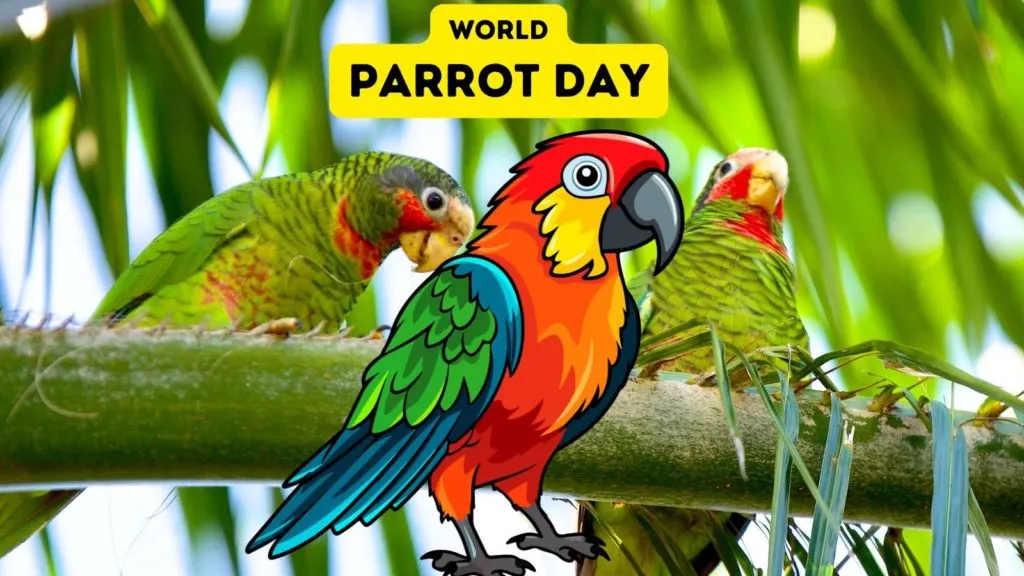World Parrot Day is an annual event dedicated to celebrating and raising awareness about one of the most colorful and charismatic members of the bird family – parrots. This day serves as a reminder of the beauty, intelligence, and diversity of parrots, as well as the conservation challenges they face.

Could You See Parrots At Your Bird Feeder?
Personally, we’ve never seen parrots at our bird feeders–but people in our area have!
In the United States, seeing parrots at backyard bird feeders is relatively uncommon but not impossible, especially in certain areas. The likelihood of encountering parrots at your feeder depends on several factors:
Geographic Location: Parrots are more likely to be seen in warmer climates, particularly in states like Florida, California, and Texas (where we live). In these regions, some non-native parrot species have established feral populations.
Feral and Introduced Populations: In some urban areas, particularly in cities like Los Angeles, San Francisco, and Miami, escaped or released pet parrots have formed self-sustaining feral colonies. Species such as Monk Parakeets (also known as Quaker Parrots) and Red-crowned Parrots are examples that can be seen in these urban environments. South Austin has a big colony of these but they’ve never made it out to our area.
Bird Feeder Placement and Food: Parrots that visit feeders are often attracted to specific types of food. They might be drawn to feeders offering seeds, nuts, or fruits, which are part of their natural diet.
Time of Year: In areas where parrots are present, they may be more likely to visit feeders during colder months when natural food sources are scarce.
If you live in an area with a known population of feral parrots, providing a bird-friendly environment with appropriate food can increase your chances of seeing these colorful birds at your feeders. However, always prioritize the needs and safety of local, native wildlife in your bird-feeding practices.
Fun Facts About Parrots
Parrots are known for their vibrant colors, remarkable intelligence, and ability to mimic human speech. They belong to the order Psittaciformes, which includes over 350 species, each with its own unique characteristics. From the majestic African Grey to the playful Cockatoo, parrots are a diverse group that captivates bird lovers worldwide. Let’s look at this fascinating group of birds!
- Diverse Family: The parrot family includes over 350 different species.
- Colorful Plumage: Parrots are known for their brightly colored feathers, which can include vibrant greens, blues, reds, yellows, and oranges.
- Longevity: Some parrot species can live for more than 50 years, and a few have been known to live over 80 years in captivity.
- Intelligence: Parrots are considered one of the most intelligent bird species. They can solve complex problems and puzzles.
- Mimicking Ability: Many parrots can imitate sounds and human speech, a trait they use in the wild to communicate and socialize.
- Strong Beaks: Parrots have powerful, curved beaks that are great for cracking nuts and seeds.
- Zygodactyl Feet: Parrots have zygodactyl feet, meaning they have two toes pointing forward and two pointing backward, which helps them grasp branches and food items.
- Geographical Range: While most parrot species are found in tropical and subtropical regions, they can be found on all continents except Antarctica.
- Diet: Parrots mainly eat seeds, nuts, fruit, buds, and other plant material, but some species also eat insects and small animals.
- Monogamous Creatures: Most parrots are monogamous and form strong bonds with their mates, often staying together for life.
- Social Behavior: Parrots are highly social birds and often live in flocks, which can range from small groups to large, noisy colonies.
- Nesting Habits: Many parrots nest in tree holes, where they can lay and protect their eggs.
- Parental Care: Both male and female parrots typically take part in raising their young.
- Communication Skills: Parrots use a variety of sounds, songs, and body language to communicate with each other.
- Playful Nature: Parrots are playful and enjoy playing with toys, interacting with their environment, and engaging in social activities.
- Variety of Sizes: Parrots come in many sizes, from the small 3.5-inch pygmy parrot to the large hyacinth macaw, which can be over 3 feet long from head to tail.
- Threatened Species: Unfortunately, many parrot species are threatened or endangered due to habitat loss, poaching, and the pet trade.
- Cognitive Abilities: Studies have shown that some parrots, like the African Grey, can perform tasks at the cognitive level of a 4- to 6-year-old child.
- Use of Tools: Some species, like the Kea parrot of New Zealand, have been observed using tools in the wild.
- Emotional Intelligence: Parrots are believed to possess a high level of emotional intelligence, capable of forming deep bonds with other parrots and humans.
World Parrot Day is more than a celebration; it’s a call to action to protect these magnificent birds. By participating in conservation efforts, educating others, and practicing responsible pet ownership, we can all contribute to ensuring that parrots continue to thrive in the wild and in our homes.
More Bird Days
BirdTipper features dozens of bird days and awareness months throughout the year; you also might enjoy these:
- 8 Letter Bird Names - August 14, 2024
- 7 Letter Bird Names - August 14, 2024
- 7 Birds Named After Famous People - July 23, 2024
